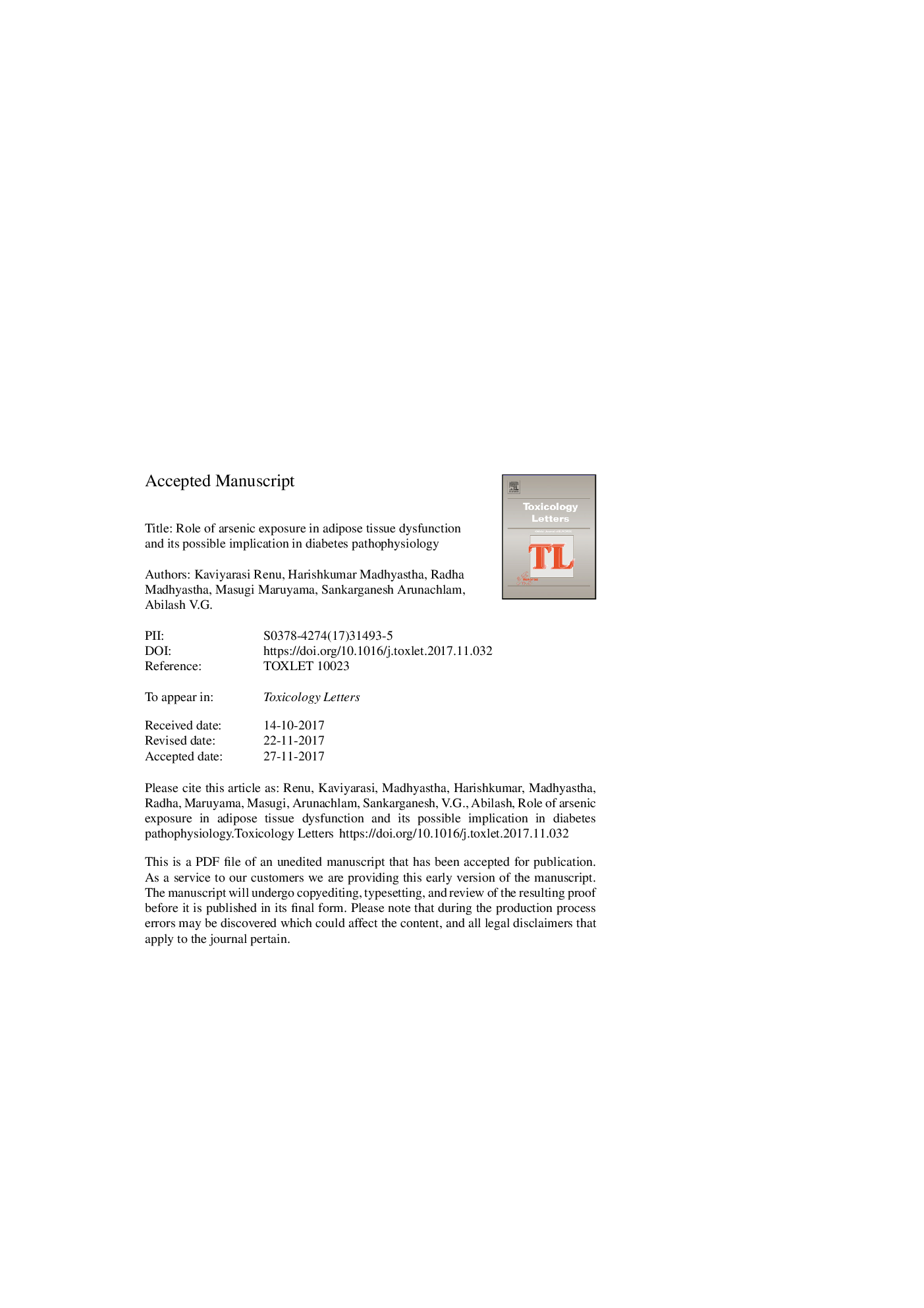| کد مقاله | کد نشریه | سال انتشار | مقاله انگلیسی | نسخه تمام متن |
|---|---|---|---|---|
| 8553471 | 1562588 | 2018 | 36 صفحه PDF | دانلود رایگان |
عنوان انگلیسی مقاله ISI
Role of arsenic exposure in adipose tissue dysfunction and its possible implication in diabetes pathophysiology
ترجمه فارسی عنوان
نقش جذب آرسنیک در اختلال عملکرد بافت چربی و پیامدهای احتمالی آن در پاتوفیزیولوژی دیابت
دانلود مقاله + سفارش ترجمه
دانلود مقاله ISI انگلیسی
رایگان برای ایرانیان
کلمات کلیدی
SREBPIRSMMAFOXO3aGPCRAP-1MnSODhMSCUPRAP-2ADRPRetinoid X receptorS1PRLPLRXRCREBADSCsPGC1αEDNRAPLIN1Egr-2CCAAT-enhancer-binding proteinsUCPX-box binding proteinCEBPInorganic arseniteXBPprotein kinase R-like endoplasmic reticulum kinasephosphatidylinositol-3-OH kinasetrivalent dimethylated arsenicCD36IGFIL-6Nrf2TNFαATFNOSEGFPPARγKLF4BATperoxisome proliferator-activated receptor gamma coactivator 1-alpha - 1-آلفا کوآتیواتور گاما گیرنده فعال پرولیسینز فعالkeap1 - buy1C/EBP homologous protein - C / EBP پروتئین همولوگG protein-coupled receptors - G گیرنده های پروتئینی همراهMAPK - MAPKα-ketoglutarate dehydrogenase - α-کتوگلووترات دهیدروژنازAdipogenesis - آدیپوژنزArsenate - آرسناتarsenite - آرسنیتArsenic - آرسنیکmonomethylarsonic acid - اسید مونومیتیلارسونیکinsulin receptor substrate - انسولین بستر گیرندهNADPH oxidase - اکسیداز NADPH interleukin 6 - اینترلوکین 6White adipose tissue - بافت چربی سفیدbrown adipose tissue - بافت چربی قهوه ایAs(V) - به عنوان (V)Diabetes - بیماری قندtriglyceride - تریگلیسریدtumor necrosis factor alpha - تومور نکروز عامل آلفاCHOP - تکه کردنforkhead Box O - جعبه O جعبه Oglucose transporter 4 - حمل کننده گلوکز 4cluster of differentiation 36 - خوشه تمایز 36electron transport chain - زنجیره انتقال الکترونAdipose tissue-derived stem cells - سلول های بنیادی حاصل از بافت چربیNitric oxide synthases - سنتز اکسید نیتروژنmanganese superoxide dismutase - سوپر اکسید دیسموتاز منگنزendoplasmic reticulum - شبکه آندوپلاسمی Insulin-like growth factor-I - عامل رشد انسولین مانند Iepidermal growth factor - عامل رشد اپیدرمیantioxidant response element - عنصر پاسخ آنتی اکسیدانnuclear factor (erythroid-derived 2)-like 2 - فاکتور هسته ای (erythroid-derived 2) -like 2nuclear factor erythroid 2-related factor 2 - فاکتور هسته ای عامل erythroid 2 مرتبط 2activating transcription factor-2 - فعال کردن عامل رونویسی 2Lipoprotein lipase - لیپو پروتئین لیپازLipolysis - لیپولیزARE - هستندAs(III) - همانطور که (III)ETc - و غیرهUnfolded protein response - پاسخ پروتئین آشکارadipocyte protein 2 - پروتئین آدیپوسیت 2Uncoupling protein - پروتئین جدا کردنKelch-like ECH-associated protein 1 - پروتئین مرتبط با ECH کلچ 1adipose differentiation-related protein - پروتئین مرتبط با تمایز چربیsterol regulatory element-binding proteins - پروتئین های الزم برای تنظیم عصاره استرولcAMP response element-binding protein - پروتئین واکنش القا کننده واکنش cAMPmitogen-activated protein kinase - پروتئین کیناز فعال با mitogenPERK - پرکPerilipin 1 - پریلیپین 1WAT - چیPeroxisome proliferator-activated receptor gamma - گاما گیرنده گیرنده فعال پرولیفیزوم فعالGlut-4 - گلوتامین 4endothelin receptor type A - گیرنده آندوتلین نوع A
موضوعات مرتبط
علوم زیستی و بیوفناوری
علوم محیط زیست
بهداشت، سم شناسی و جهش زایی
چکیده انگلیسی
Exposure to arsenic in drinking water can stimulate a diverse number of diseases that originate from impaired lipid metabolism in adipose and glucose metabolism, leading to insulin resistance. Arsenic inhibits differentiation of adipocyte and mediates insulin resistance with diminutive information on arsenicosis on lipid storage and lipolysis. This review focused on different mechanisms and pathways involved in adipogenesis and lipolysis in adipose tissue during arsenic-induced diabetes. Though arsenic is known to cause type2 diabetes through different mechanisms, the role of adipose tissue in causing type2 diabetes is still unclear. With the existing literature, this review exhibits the effect of arsenic on adipose tissue and its signalling events such as SIRT3- FOXO3a signalling pathway, Ras âMAP âAP-1 cascade, PI(3)-K-Akt pathway, endoplasmic reticulum stress protein, C/EBP homologous protein (CHOP10) and GPCR pathway with role of adipokines. There is a need to elucidate the different types of adipokines which are involved in arsenic-induced diabetes. The exhibited information brings to light that arsenic has negative effects on a white adipose tissue (WAT) by decreasing adipogenesis and enhancing lipolysis. Some of the epidemiological studies show that arsenic would causes obesity. Few studies indicate that arsenic might induces lipodystrophy condition. Further research is needed to evaluate the mechanistic link between arsenic and adipose tissue dysfunction which leads to insulin resistance.
ناشر
Database: Elsevier - ScienceDirect (ساینس دایرکت)
Journal: Toxicology Letters - Volume 284, 1 March 2018, Pages 86-95
Journal: Toxicology Letters - Volume 284, 1 March 2018, Pages 86-95
نویسندگان
Kaviyarasi Renu, Harishkumar Madhyastha, Radha Madhyastha, Masugi Maruyama, Sankarganesh Arunachlam, Abilash V.G.,
